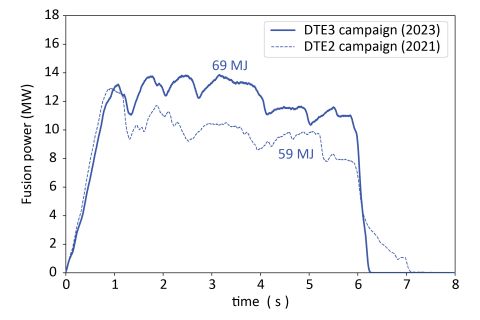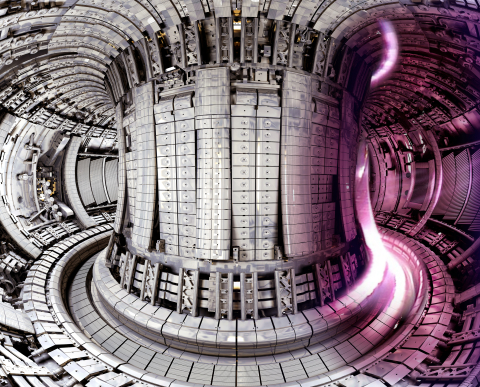The latest tritium experiments at fusion research facility Joint European Torus (JET) have produced a new energy record. JET, one of the largest and most powerful fusion machines in the world, has demonstrated that it can reliably generate fusion energy while setting a world record in energy output. A major milestone in the field of fusion science and engineering.
- Fusion energy reliably generated due to the unique capabilities of the Joint European Torus (JET) facility in Oxford
- Major scientific achievements reflect unparalleled dedication and effectiveness of the international team of scientists and engineers at JET, including scientists from DIFFER, the Dutch Institute for Fundamental Energy Research
- JET has played a central role in accelerating the development of fusion energy
In JET's final deuterium-tritium experiments (DTE3), high fusion power was consistently produced for 5.2 seconds, resulting in a ground-breaking record of 69.26 megajoules using a mere 0.21 milligrams of fuel. JET is a tokamak, a design which uses powerful magnetic fields to confine a plasma in the shape of a doughnut.
European collaboration
Over 300 scientists and engineers from EUROfusion – a consortium of researchers across Europe, contributed to these landmark experiments at the UK Atomic Energy Authority (UKAEA) site in Oxford, showcasing the unparalleled dedication and effectiveness of the international team at JET.
JET is the only existing facility of its kind that can operate with the high-grade deuterium-tritium fuel mix that will be used in future fusion power plants.
JET’s research findings have critical implications not only for ITER – a fusion research mega-project being built in the south of France – but also for the UK’s STEP prototype powerplant, Europe’s demonstration powerplant, DEMO, and other global fusion projects, pursuing a future of safe, low-carbon, and sustainable energy.

Dutch contribution
During the JET experiments, scientists from DIFFER collaborated extensively with the European teams. The DIFFER team mainly focused on developing fast algorithms that ensure that the heat load on the fusion reactor wall does not become too high.
Thomas Bosman, PhD student at DIFFER and involved in the experiments: "Controlling the heat load on the walls of the reactor is a close process. It is done by injecting noble gases close to the wall. This has to be done very precisely because too much gas can compromise the whole experiment. We have shown that by working systematically, we can design working controllers (algorithms) very efficiently (with little experimental time). The controllers use measurements of the plasma to adjust the amount of injected noble gas very quickly (every 0.002 seconds), keeping the heat load on the wall under control without affecting the fusion performance."
In addition, the team investigated how to control the deuterium-tritium fuel mix. They did this by injecting tritium gas and frozen pellets (ice-cold balls) of deuterium. In 2022, Matthijs van Berkel, group leader Energy Systems & Control at DIFFER, received a Vidi grant from the Netherlands Organisation for Scientific Research (NWO) to conduct research on this.
Van Berkel: "As 2023 was the last year of JET operation, I felt it was important to test how the deuterium-tritium fuel mix varies dynamically under the influence of pellets in Europe's largest nuclear fusion reactor. The dynamic models that will be validated and further developed based on these experiments will play a crucial role in developing control techniques that determine the performance of future reactors."
Lennard Ceelen, PhD candidate at DIFFER involved in these experiments: "The ice pellets contain fuel, are cooled to -260 degrees and are launched at high speed into the scorching 100million-degree fusion plasma. This is technically very challenging and the only way to efficiently add new fuel to the fusion plasma. These experimental results show that ice pellets can be used to control conditions in the plasma. This is essential in the successful operation of future fusion reactors."
Decades
JET has been instrumental in advancing fusion energy for over four decades, symbolising international scientific collaboration, engineering excellence, and the commitment to harness the power of fusion energy – the same reactions that fuel the Sun and stars.
JET demonstrated sustained fusion over five seconds at high power and set a world-record in 2021. JET’s first deuterium-tritium experiments took place in 1997. The achievements at JET, from the major scientific milestones to the setting of energy records, underscores the facility’s enduring legacy in the evolution of fusion technology. Its contributions to fusion science and engineering have played a crucial role in accelerating the development of fusion energy, which promises to be a safe, low carbon and sustainable part of the world’s future energy supply.

Reactions to the energy record
- Dr Fernanda Rimini, JET Senior Exploitation Manager, JET Scientific Operations Leader: “We can reliably create fusion plasmas using the same fuel mixture to be used by commercial fusion energy powerplants, showcasing the advanced expertise developed over time.”
- Professor Ambrogio Fasoli, Programme Manager (CEO) at EUROfusion:“Our successful demonstration of operational scenarios for future fusion machines like ITER and DEMO, validated by the new energy record, instil greater confidence in the development of fusion energy. Beyond setting a new record, we achieved things we’ve never done before and deepened our understanding of fusion physics.”
- Emmanuel Joffrin, EUROfusion Tokamak Exploitation Task force Leader from CEA: “Not only did we demonstrate how to soften the intense heat flowing from the plasma to the exhaust, we also showed in JET how we can get the plasma edge into a stable state thus preventing bursts of energy reaching the wall. Both techniques are intended to protect the integrity of the walls of future machines. This is the first time that we've ever been able to test those scenarios in a deuterium-tritium environment.”
- Minister for Nuclear and Networks, Andrew Bowie: “JET's final fusion experiment is a fitting swansong after all the groundbreaking work that has gone into the project since 1983. We are closer to fusion energy than ever before thanks to the international team of scientists and engineers in Oxfordshire. The work doesn’t stop here. Our Fusion Futures programme has committed £650 million to invest in research and facilities, cementing the UK’s position as a global fusion hub.”
- Professor Sir Ian Chapman, UKAEA CEO:“JET has operated as close to powerplant conditions as is possible with today’s facilities, and its legacy will be pervasive in all future powerplants. It has a critical role in bringing us closer to a safe and sustainable future.”
- Pietro Barabaschi, ITER Director-General: “Throughout its lifecycle, JET has been remarkably helpful as a precursor to ITER: in the testing of new materials, in the development of innovative new components, and nowhere more than in the generation of scientific data from Deuterium-Tritium fusion. The results obtained here will directly and positively impact ITER, validating the way forward and enabling us to progress faster toward our performance goals. On a personal note, it has been for me a great privilege having myself been at JET for a few years. There I had the opportunity to learn from many exceptional people.”
Read more about this news in the Q&A with DIFFER researcher Matthijs van Berkel and on the EUROfusion website.
Experimenten Joint European Torus (JET) leveren nieuw energierecord op
De laatste tritiumexperimenten van fusieonderzoeksfaciliteit Joint European Torus (JET) hebben een nieuw energierecord opgeleverd. JET, een van de grootste en krachtigste fusiemachines ter wereld, heeft aangetoond dat het op betrouwbare wijze fusie-energie kan opwekken met tegelijkertijd een wereldrecord in energieopbrengst. Een belangrijke mijlpaal op het gebied van fusiewetenschap en -techniek.
- Fusie-energie betrouwbaar opgewekt dankzij de unieke mogelijkheden van de Joint European Torus (JET) faciliteit in Oxford
- Belangrijke wetenschappelijke resultaten weerspiegelen de ongeëvenaarde toewijding en effectiviteit van het internationale team van wetenschappers en ingenieurs bij JET, waaronder wetenschappers van het Nederlandse onderzoeksinstituut DIFFER
- JET heeft een centrale rol gespeeld in het versnellen van de ontwikkeling van fusie-energie
Tijdens JET's laatste deuterium-tritiumexperimenten (DTE3) werd een constant fusievermogen geproduceerd gedurende 5,2 seconden. Dit had een baanbrekend record van 69.26 megajoules tot gevolg bij gebruik van slechts 0,21 milligram brandstof. JET is een tokamak, een ontwerp in de vorm van een donut dat krachtige magnetische velden gebruikt om een plasma op te sluiten.
Europese samenwerking
De experimentele campagne bij JET werd uitgevoerd door meer dan 300 wetenschappers uit heel Europa die deelnamen aan EUROfusion, samen met technische en wetenschappelijke medewerkers van het Britse Atoomenergie Agentschap (UKAEA). JET is de enige bestaande faciliteit in zijn soort die kan werken met de hoogwaardige deuterium-tritium brandstofmix die in toekomstige fusiecentrales zal worden gebruikt.
De onderzoeksresultaten van JET hebben cruciale gevolgen, niet alleen voor ITER -een megaproject voor fusieonderzoek dat in Zuid-Frankrijk wordt gebouwd- maar ook voor de STEP-prototypecentrale in het Verenigd Koninkrijk, Europa's demonstratiecentrale DEMO en andere wereldwijde fusieprojecten die een toekomst van veilige, koolstofarme en duurzame energie nastreven.
Nederlandse inbreng
Tijdens de JET-experimenten hebben wetenschappers van DIFFER, het Dutch Institute for Fundamental Energy Research in Eindhoven, uitgebreid samengewerkt met de Europese teams. Het DIFFER-team richtte zich vooral op het ontwikkelen van snelle algoritmes die er voor zorgen dat de warmtelast op de wand van de fusiereactor niet te hoog wordt.
Thomas Bosman, promovendus bij DIFFER en betrokken bij de experimenten: “Het regelen van de warmtelast op de wanden van de reactor is een nauw proces. Het wordt gedaan door edelgassen te injecteren dicht bij de wand. Dit moet heel precies gebeuren, want te veel gas kan het hele experiment in gevaar brengen. Wij hebben laten zien dat we door systematisch te werken heel efficiënt (met weinig experimentele tijd) werkende regelaars (algoritmes) kunnen ontwerpen. De regelaars maken gebruik van metingen van het plasma om de hoeveelheid geïnjecteerde edelgas heel snel (elke 0.002 seconden) aan te passen, zodat de warmtelast op de wand onder controle blijft zonder de fusieprestaties aan te tasten.”
Daarnaast deed het team onderzoek naar hoe de deuterium-tritium brandstofmix te regelen is. Dit deden zij door tritiumgas en bevroren pellets (ijskoude balletjes) deuterium te injecteren. In 2022 ontving Matthijs van Berkel, groepsleider Energy Systems & Control bij DIFFER een Vidi-beursvan de Nederlandse Organisatie voor Wetenschappelijk Onderzoek (NWO) om hier onderzoek naar te doen.
Van Berkel: “Aangezien 2023 het laatste jaar was dat JET opereerde, vond ik het belangrijk om te testen hoe de deuterium-tritium brandstofmix dynamisch varieert onder invloed van pellets in de grootste kernfusiereactor van Europa. De dynamische modellen die op basis van deze experimenten gevalideerd en verder ontwikkeld zullen worden, spelen een cruciale rol in het ontwikkelen van regeltechniek die de prestaties van toekomstige reactors bepalen.”
Lennard Ceelen, als PhD-kandidaat bij DIFFER betrokken bij deze experimenten: “De ijspellets bevatten brandstof, zijn gekoeld tot -260 graden en worden met hoge snelheid gelanceerd in het verzengende fusieplasma van 100miljoen graden. Dit is technisch zeer uitdagend en de enige manier om efficiënt nieuwe brandstof toe te voegen aan het fusieplasma. Deze experimentele resultaten tonen aan dat de ijspellets gebruikt kunnen worden om condities in het plasma te regelen. Dit is van essentieel belang in de succesvolle werking van toekomstige fusiereactoren.”
Decennialang
JET speelt al meer dan vier decennia een belangrijke rol bij het bevorderen van fusie-energie en staat symbool voor internationale wetenschappelijke samenwerking, uitmuntende technische prestaties en het streven om de kracht van fusie-energie te benutten; dezelfde reacties die de zon en sterren van energie voorzien.
De eerste deuterium-tritium experimenten van JET vonden plaats in 1997. In december 2021 liet JET een recordvermogen aan fusie-energie zien van 59 megajoule in een puls van vijf seconden. JET beëindigde zijn wetenschappelijke activiteiten eind december 2023.
De prestaties van JET -van de belangrijkste wetenschappelijke mijlpalen tot het vestigen van energierecords- onderstrepen de blijvende erfenis van de faciliteit in de evolutie van de fusietechnologie. De bijdragen aan de fusiewetenschap en -techniek hebben een cruciale rol gespeeld in het versnellen van de ontwikkeling van fusie-energie, die een veilig, koolstofarm en duurzaam onderdeel van de toekomstige wereldwijde energievoorziening belooft te worden.
Read more about this news in the Q&A with DIFFER researcher Matthijs van Berkel and on the EUROfusion website.
Go to the News page.